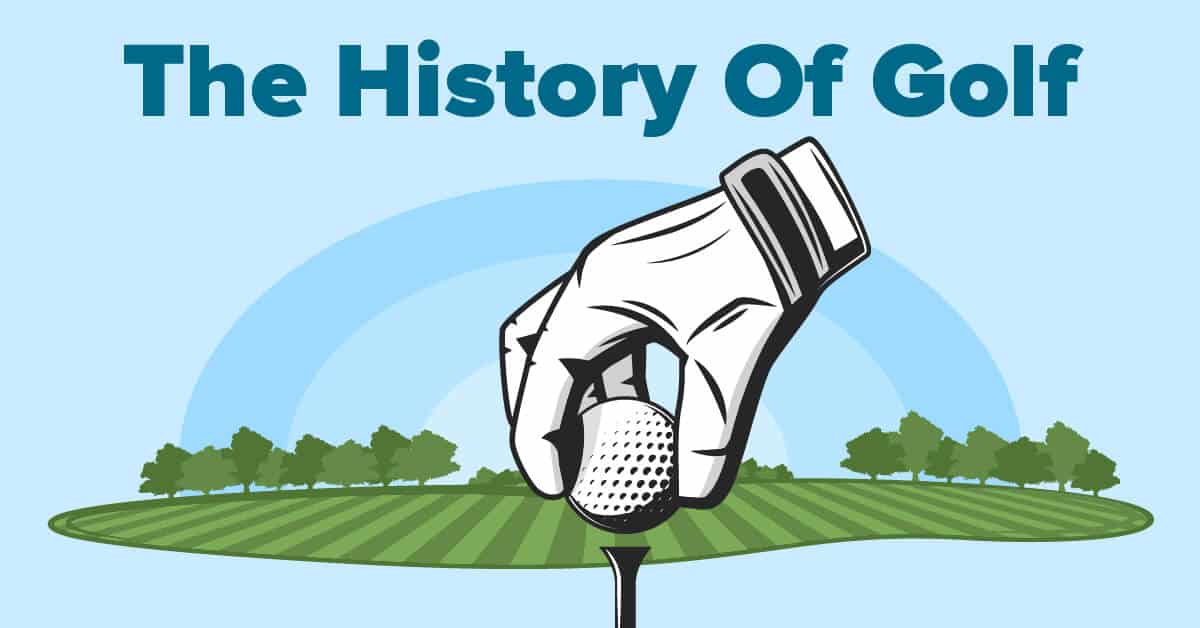Introduction
Golf is one of the most famous, instantly recognizable sports in the world. Where most club-and-ball games fall into niche subcultures, everybody knows a golf club when they see one, and the same can be said about the dimpled surface of a golf ball.

Often seen as a game for the prestigious and wealthy, golf is played by people all over the world. Today we’re finding out where golf started, along with other pertinent information that helps us understand the sport and how it came to dominate much of the planet.
Getting into history and sports lore can be tricky, mainly in deciding how much detail we should include. That’s why we have used references, to back up our information and provide more reading material for avid golf fans.
We have over 500 years to cover, so let’s get started with the basics. We have a timeline of the history of golf below, so check that out if you’re looking for the origins of golf recorded step-by-step. For now, we’re starting by answering some basic questions you may have about the sport.
Table of Contents
- Introduction
- Who Invented Golf?
- Why Is It Called Golf?
- How Did Golf Develop Over Time?
- When Did Golf Become Really Big?
- The History Of Golf: A Timeline
- Who Are The Most Famous Golf Players Of All Time?
- Summary
Who Invented Golf?
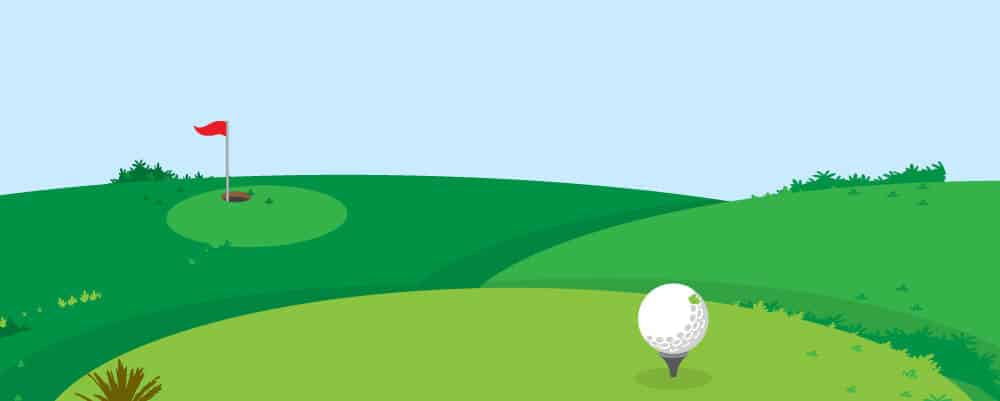
You may have heard that golf originated in Scottish culture. However, like so many sports, that’s just where we know modern golf came from. There is a lot of debate about where golf came from by sports historians because the Scots may have been playing it for decades before thinking to write it down, and it may have come from elsewhere before that.
Ancient stick-and-ball games have been found in Europe, Asia, and Africa throughout the 1000s, with the earliest example coming from China. The games were far from golf, acting as a distant relative of the sport we’re talking about today.
Another early game that resembled golf was played in 1297, in the Dutch town of Loenen aan de Vecht. The game involved hitting a leather ball with a stick, with the winner being the person who could reach their target in the fewest strokes. Documents from the period suggest this game was kolven, or kolf as a noun, which was later banned in the 1300s. Here’s an art piece depicting a kolf game.
During this time, there were Scottish examples of early golf being played. A 1400s act of Scottish parliament outlawed the playing of ‘gowf’ and ‘futball’ because it distracted people from practicing archery, which was necessary for the event they were levied for battle.
Were the Dutch responsible for golf or was it the Scottish? References to kolf continue in Flemish texts into the 1500s, where our timeline of the history of golf begins. We do know that kolfmade its way to the USA in the 1600s, where it was played by settlers in Fort Orange, New York.
The answer may lie in the etymology of the word golf. So, why is it called golf?
Why Is It Called Golf?
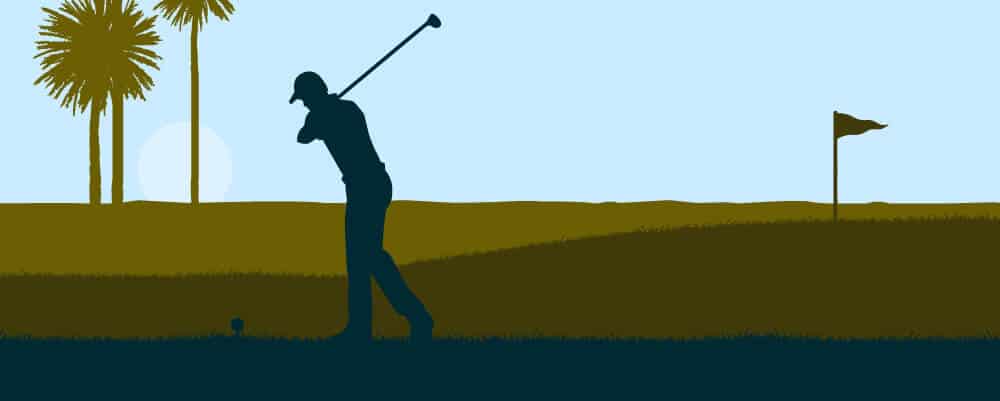
The word golf came from somewhere and by tracking the etymology of words, we can learn more about where the sport originated. We are already familiar with kolf, which is a Dutch word for club and was used for their old sport.
Around the same time, in the 1300s and 1400s, we see terms like gowf, goff, and gouff being used in both the Netherlands and Scotland. Then, in the 1500s, we have the first mentions of the word golf.
This indicates that the Scottish terms for golf, which later became the most popular name for it, came from kolfand the Dutch names for similar games. Some historians believe that trading between the Netherlands and Scotland is responsible for the connection. The Netherlands is quite close, after all, and Scotland had close ties to the Dutch due to their religious similarities.
While the name may have come from a similar game, golf is more than just a word. It was Scotland who popularized the name, established the first courses and clubhouses, and made the first draft of written rules. They also started the 18-hole course, which lent itself to tournament structures and competitions.
With that in mind, the name may have come from Dutch origins, but it was the Scottish who developed golf into what it is today. Let’s go into more detail on how golf developed over time.
How Did Golf Develop Over Time?

Every sport has changed a lot since it was first invented and golf is no exception. In fact, it’s rare for somebody to just create a sport out of nowhere, most develop over centuries (sometimes millennia) until they become the sport we know today.
Even then, they are constantly changing and golf in 100 years might look different from the golf being played today. That’s why figuring out who invented golf is so difficult – it can be hard to put your finger on a certain point because it’s a centuries-long process.
Kolf
While kolf isn’t golf – modern versions of kolf are played today and it’s a different sport – let’s look at the rules of kolf for posterity. It’s clear that kolf in the Netherlands inspired Scottish golf in some ways. While we’ll never know how, exactly, we can appreciate how the rules changed from kolf to golf over time.
Here’s a step-by-step explanation of kolf:
- The game is played with few players, typically four.
- In summer, it was played in fields. In winter, it was played on ice.
- A target is established nearby, marked with a dedicated kolf stake or a makeshift landmark. Sometimes it was a hole in the ground and the distance varied between games and players.
- The players take turns hitting the ball with their club.
- The winner is the person who can reach the target with the fewest hits.
As we said, modern kolf is played in the Netherlands. The modern version is often played indoors, the court being 19 by 5.5 yards with a pole at one end as the target. The goal is to hit the ball as close to this pole as possible, with rings painted around it to determine how scoring works.
This sounds quite different from the old kolf – it’s like a combination of the old kolf and curling.
Kincaid’s Golf
In the 16th Century, golf was played all over the Scottish countryside. It was an informal, friendly game that wasn’t often regarded with the same prestige many give it today. In fact, it was a favorite of shepherds and other cattle herders since they’d play it on public land. In grazing, their cattle would mow the local lawns while their owners passed time with golf.
The oldest ruleset we have for golf is from the diary of Thomas Kincaid, a prominent medical student in the 1600s who was an avid archer and golfer. Having played near Edinburgh University, he included notes on his games.
While the word handicap wasn’t used yet, his diary essentially laid out an early handicap system for golf. Unsurprisingly, it details that the players need to decide on how much handicap was given to certain players and on which holes they apply.
Kincaid also noted that the best golf balls are those made of harder leather, without any weak grains or pores that could facilitate the passing of a needle. This would foreshadow the preference toward a harder ball in modern golf. Note that, at this time, clubs were made from hand-crafted wood (beech heads with shafts of hazel or ash), and the balls were balled feathers wrapped in leather hide. You can see some old golf clubs here.
The Leith Rules
Kincaid’s diary doesn’t go into great detail about golf, so our next best source is from the Company of Gentlemen Golfers (later the Honourable Company of Edinburgh Golfers) who wrote ‘Articles and Laws in Playing at Golf.’ That’s a mouthful, however, so they are called the Leith Rules because they played at the Leith Links.
Written in 1744, they claim to be the oldest golf club. This is debated, however, as the Royal Burgess Golfing Society had been established in 1735.
The Leith Rules get into the minutiae, which may seem redundant but is important when fleshing out a sport. There are thirteen rules in total, which we have translated into modern English below:
- Tee the ball within a club’s length of the hole.
- Your tee must be placed on the ground.
- You are not allowed to change the ball which is hit off the tee.
- You cannot remove stones or debris unless you’re on the green and it is within a club’s length of you.
- If the ball falls into water, you can take it out and tee it up behind the hazard. You must then allow your opponent a stroke for fouling.
- If the golf balls touch each other, the ball that made the first contact should be lifted and the second should play.
- You are to aim for the hole, not to aim for the opponent’s ball.
- If you lose your ball, you should strike from the same spot where you struck the lost ball. Allow your opponent another stroke for fouling.
- Hitters aren’t allowed to mark their path to the hole in any way when lining up their shot.
- If the ball gets stopped by a dog, horse, person, or other animals, resume from the spot where the ball stopped moving.
- A stroke that involves bringing down your club is counted as a stroke, even if you don’t make contact with the ball.
- The person with their ball furthest away from the hole goes first.
- Certain parts of a links course, like trenches, scholar’s holes, and soldier’s lines, are hazards. Instead, a ball that falls into them should be taken out, teed, and hit with any club.
The First 18-Hole Course
It was only a few short decades after the Leith Rules were written down that the first 18-hole course came into existence. It was constructed at St. Andrews in Edinburgh, which isn’t surprising given that Edinburgh was a golfing hub. The university was one of Britain’s most prestigious too, which probably started the perception that golf is an esteemed and expensive game to indulge in.
Having been established in 1764, the 18-hole course became a standard for golf that dictated how many holes were played and how long they tended to be.
For the rest of the 1700s and 1800s, golf spread to British territories through learned people who had played golf at university. The most notable examples are the oldest English and Indian clubs – the Royal Blackheath Golf Club in 1766 and the Royal Calcutta Golf Club in 1829.
The Royal & Ancient Golf Club
In 1754, the Society of St. Andrews Golfers was formed around the St. Andrews Links. In 1834, they were honored with ‘Royal & Ancient’ as a title by King William IV and are also one of the oldest golf clubs in the world. They also issued their codified rules of golf in 1897.
Due to their prestige, tournaments and other courses invited them to regulate games. The R&A, as they started to be called, grew over the next decades to become a management body for the sport. In 2004, the R&A separated from its St. Andrews association to become one of the world’s regulatory bodies alongside the USGA.
The USGA Is Established
The USGA is the United States Golf Association, which was formed in 1894 to regulate the emerging American golfing scene. By the turn of the new century, thousands of clubs had formed in the USA.
While Britain made use of the links courses that were available to them (and still do today) the Americans sculpted the land into parklands for golf games. As we mentioned above, the USGA is still going strong as a regulatory body for American golf.
When Did Golf Become Really Big?

The popularity of golf exploded in the 1800s. This was first facilitated by new railway ties to London from Edinburgh. Scottish tourism was booming during this time as Scottish culture became the interest of Britain and the world. Alongside this, gutta-percha golf balls were developed and were easier to mass-produce than leather and feather combinations.
In 1880, England had approximately twelve courses. By 1914, the number had exploded to over 1,000. This popularity also gave us the very first British Open Champion, a dapper gentleman called John Ball.
Throughout the 1800s and the early 1900s, golf then spread throughout the British empire. As we mentioned already, it made its way to India, but it also traveled as far as New Zealand and South Africa too. It also expanded beyond the empire through trade, with the Tokyo Golf Club being established by the native Japanese in 1913.
In the USA, kolf games played by settlers were replaced with golf in the 1800s. After the founding of the USGA, women’s golf was established a year later. Two people are often credited for signal boosting golf in America – John Reed and Elizabeth Reed. Each founded their own club, John making the St. Andrew’s Club in New York while Elizabeth made Saegkill G.C., a women’s club.
Golf had become an American mainstay sport by the early 1900s, where amateur golfer Bobby Jones won the world’s first Grand Slam in 1930 – which back then was the British Open, the U.S. Open, the British Amateur, and the U.S. Amateur.
This was the first usage of the phrase Grand Slam and, by those original standards, no player has made a Grand Slam again. Under the modern Grand Slam definition, Jack Nicklaus became the next player to achieve one in the ‘60s, ‘70s, and ‘80s.
The History Of Golf: A Timeline

Having established much of golfing history, here’s a timeline that covers the most important points from the 1500s to the modern-day. While some things have been mentioned above, there are details here we haven’t included in our guide so far!
1500s – 1600s
The 1500s and 1600s are a murky period where we know that golf was played in Scotland, specifically in the kingdom of Fife. Golfing equipment wasn’t used, making use of pebbles, sticks, and even rabbit burrows to play.
As we mentioned, golf-like games had been played since 1000 AD but most people would not consider them golf, only distantly related ancestors and cousins to the sport. If you remember, King James II (who was King James IV for Scotland) and other leaders also resisted golf because it distracted people from archery training. He also commissioned the first golf clubs later in his life, hiring bowmaker William Mayne for the job.
1750s
It wasn’t until the 1750s that wood-carved golf clubs became prolific in Scotland. Most of the oldest golfing tools came from this period, though there was probably older equipment that was recycled or destroyed by the passage of time. Blacksmiths also made iron club heads for the clubs.
1754
As we covered, this was when the Royal & Ancient Golf Club was established. While there were golfing clubhouses in the 1730s and ‘40s, which we also mentioned above, the R&A would have the most profound impact on golf. This makes 1754 a foundational date for golf, especially the mainstreaming and standardization of it since they came up with some of the first codified rulesets.
1770s
While kolf was still being played in America in the 1650s, it was the 1770s where golf seemed to gain traction in the new world. Snippets from The Royal Gazette, a New York newspaper, contained advertisements for golfing equipment for new, interested players.
1848
Gutta-percha golf balls were invented by Robert Adams Paterson, a clergyman, and St. Andrews alumni.
To elaborate, gutta-percha is a thermoplastic latex made from a plant of the same name. It’s rubbery, so it responds well to impact, while also being more durable than the feather balls wrapped in hard leather.
It was also cheap to make and easier to mass-produce, allowing everybody to enjoy golf. Where the old feather/leather balls had been called ‘featheries,’ the new gutta-percha balls were called ‘gutties.’
1867
In many places, golf was seen as a man’s game and so women were barred from participating. This started to change in 1867 when the first women’s golf club was created at, you guessed it, St. Andrews University. It was made because members of the R&A Golf Club, who had grown older and started families, wanted a place for their daughters to learn golf.
1895
1895 was when the first U.S. Open took place. The action took place on a large 36-hole course based in Rhode Island, which had to be played in just one day. The reward was $150 in cash, a gold medal, and a trophy.
Of course, it also came with the bragging rights of being the first U.S. Open champ. That would be a young man called Horace Rawlins. He placed second in the 1896 U.S. Open, too, and was involved with designing golf courses into the early 1900s.
1899
While it may be hard to imagine, the specialized golf tee was only invented in 1899. Before the invention of the tee, golfers made mounds of sand and dirt to hit their balls from. The tee was the work of Dr. George Grant, who improved on a previous design patent by British inventor Percy Ellis in 1890, called the Perfectum tee.
Grant made the tee smaller and out of wood. He was also a renowned dentist and the first African-American man to attend Harvard University.
1900
Golf was played at the Paris 1900, officially called the Games of the II Olympiad or, as we’d call it nowadays, the 1900 Summer Olympics. The event was part of the World Fair, so many athletes weren’t aware that they had performed at the Olympic Games.
Golf also made an appearance at St. Louis for the 1904 Olympics. In both cases, it wasn’t quite the Olympics that we know yet, which became more popular after 1924. Golf is still played at the Olympics today, though the format is a bit different.
1916
In 1916, the first mini-golf courses were made by James Barber. Barber was a steamship business owner who made the mini-course for his home in Pinehurst, North Carolina. It wasn’t your average 18-hole course, featuring a zigzagging walkway, embedded gardens, and a fountain feature. Even today, the mini-golf course hasn’t changed too much!
1929
The very first PGA Tour event started in 1829. At first, the event was limited to the West Coast, though with some held in Florida and Texas. In time, and especially after World War II, the PGA Tour became the more popular institution that it is today.
1930
A careful golfer called Phil Young played a round of golf with his dentist this year. Why is that important? Well, Young missed a putt and became frustrated at the ball. Together, they X-rayed the ball and found that the rubber inside it was off-center and interfering with his game.
After finding a pattern in several golf balls Young, who was an MIT graduate, made his own line of golf balls. This would become a small company called Titleist, which quickly became the most popular golf ball brand within the next decade.
1932
J.K. Wadley uses a motorized transport cart at his local Texarkana golf course. After seeing motorized carts traveling in Los Angeles, where they were used to transport the elderly to the local grocery stores, he figured he could use it to move between holes at the course. The first electric golf cart was made in 1932 but was not met by much fanfare and Wadley’s initial attempts fell short.
It was only in the 1950s that golf carts took off on the courses and parklands of America. A Californian native, Merle Williams, was behind the production of electric carts after fuel rations during the war. The first gas-powered cart came in the ‘50s from somebody called Max Walker and Harley-Davidson was manufacturing carts in the ‘60s.
1934
In Augusta, Georgia, the very first Masters Tournament took place. Bobby Jones, who we mentioned in the first half of this page, wanted to build a golf course after he had retired. He worked with investor Clifford Roberts to create the invitational event where only the best of the best golfers could compete. The iconic green jacket associated with the Masters came to be in 1949 and the Champions Dinner in 1952.
1976
The Zebra putter, named because it has a striped pattern on it, is introduced into the golfing industry. They would become more popular in the 1990s, thanks to players like Nick Price.
1982
The next biggest name in golfing equipment – Callaway – starts in California. The Callaway Golf Company was started by former Burlington Industries president Ely Callaway Jr. At first they made golf clubs but today they offer a wider variety of golfing equipment. Their most famous club in the early years was their ‘Big Bertha’ driver.
1984
1984 was where Nike, which had already established itself as a footwear and clothing company, expanded into the golfing industry. They offered clubs, balls, bags, and of course golf-related clothing like polo shirts.
2006
The Nintendo Wii, which makes use of motion-sensing technology to control its videogames, releases Wii Sports. One of the sports was golfing, which isn’t surprising given the mainstream popularity of golf in the 21st Century.
Wii Sports allowed people all over the world to simulate playing golf without finding a parkland to play it in. While it isn’t anywhere near real golf in terms of difficulty, it no doubt inspired some to pick up a real golf club afterward.
2019
In 2019, virtual simulator rooms allow players to play golf indoors. With VR and metaverse technology improving rapidly, the idea of VR/metaverse sports keeps getting brought up.
Once again, it’s not the real thing, but it does bring new interest to the sport as a whole. It also hints at where the future of the sport is going, where virtual leagues exist and players compete against one another in digital spaces too.
Who Are The Most Famous Golf Players Of All Time?
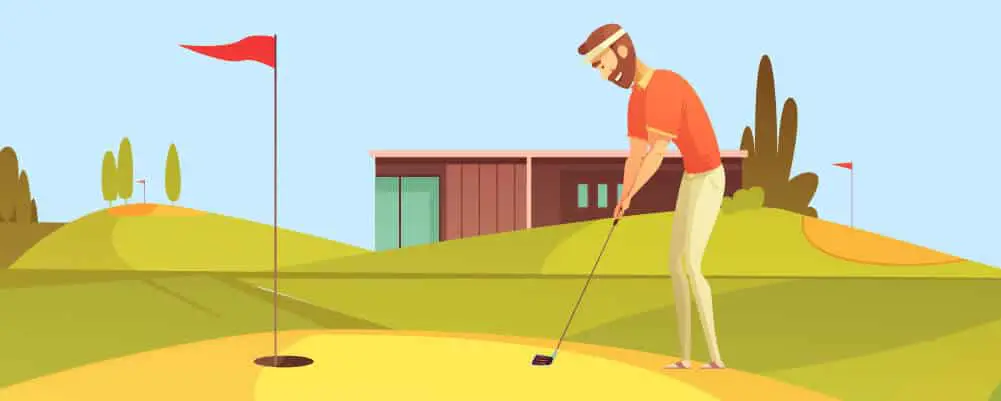
That’s pretty much everything you need to know about the history of golf!
To bring this guide to a close, here are some of the most famous golf players of all time, from their impact on the sport to how effective they were at the game.
- John Rattray – While he isn’t exactly famous, John Rattray is one of the earliest influential figures in golf. As an Edinburgh surgeon in the 1700s, he was the Captain of Golf for the Company of Gentlemen Golfers when they first issued the first golf ruleset, which was also signed by him.
- Allan Robertson – The most famous golfer before the founding of the Open Championship (better known now as The Open or the British Open) from 1843 till 1859. He was considered the best in the world at the time, making a living by playing for bets.
- Young Tom Morris – A pioneer of professional golf and son of Old Tom Morris, who also played. He was the first young golf prodigy in history and won four consecutive Open Championship titles during the early years. He still holds the PGA record for youngest championship win at just 17.
- John Ball – As mentioned earlier here, John Ball was an English amateur golfer who became the first British person to win the Open Championship in 1890, along with the amateur championship.
- Glenna Collett-Vare – Dubbed the Queen of American Golf, Collett-Vare was the biggest name in female golfing during the 1920s.
- Bobby Jones – Bobby Jones was the first and only golfer to achieve an original Grand Slam, winning both the pro and amateur championships in the US and UK in one year, which was 1930. He was also influential in the industry, co-founding the Masters Tournament.
- Arnold Palmer – Nicknamed ‘The King,’ Palmer was the first golf superstar of the television age in the 1950s. He was modest and plain-spoken, making golf seem more accessible for many fans.
- Gary Player – The only non-American to achieve a career Grand Slam, Gary Player is considered one of the best alongside Palmer and is also an architect who designed over 400 golf courses worldwide.
- Jack Nicklaus – Alongside Palmer and Player, Jack Nicklaus was the last of the big three golf stars of the 1960s. Along with being one of the best players, he was the first Masters Tournament winner to place first two years in a row. With 18 majors, he also holds the record for most majors won. Like Player, he runs a golf course design company nowadays.
- Tiger Woods – No doubt the most famous golfer of all time, Tiger Woods holds numerous records and, unlike some others in this list, he’s one of the more modern players. Going pro in the 1990s, his name still looms over golfing despite many setbacks and controversies throughout his life.
- Rory McIlroy – Turning pro after becoming world #1 amateur at just 17, McIlroy is another big name in modern golfing. It proved to be the right decision, as he became the youngest most profitable player in the European and PGA Tours. Only Nicklaus, Woods, and McIlroy have won four major titles before turning 25.
Summary
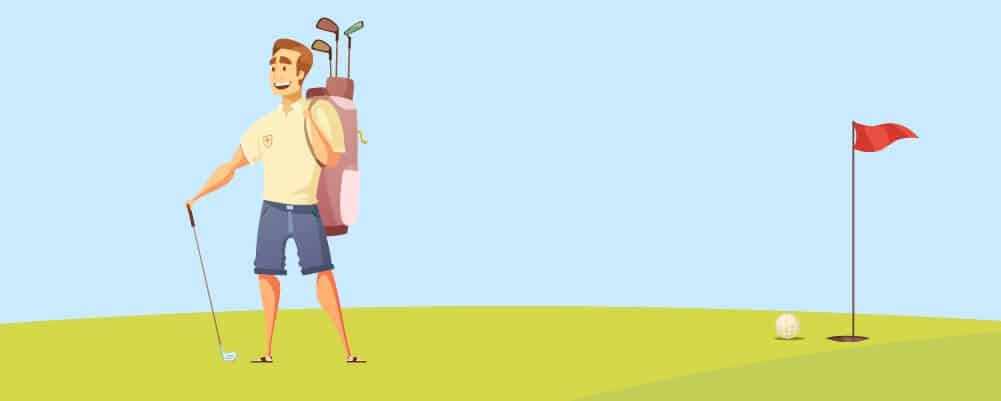
With that, you have learned the history of golf. From the earliest Dutch and Scottish club-and-ball games, we have traced the journey of golf and how it developed over time. We also explained how the rules have changed and who changed them, with some explanation of the most famous and influential figures from the sport’s history. Now that we have caught up, all that’s left to wonder is what the future of golf will look like. With digital technology trying to capture and simulate many sports, we have a feeling that real modern golf is here to stay.
- Should Tee Boxes Be Level? - January 23, 2024
- 3 Hybrid Distance - November 15, 2023
- Innovations in Golf Mobility: An In-depth Review of Top Golf Scooters - October 12, 2023
